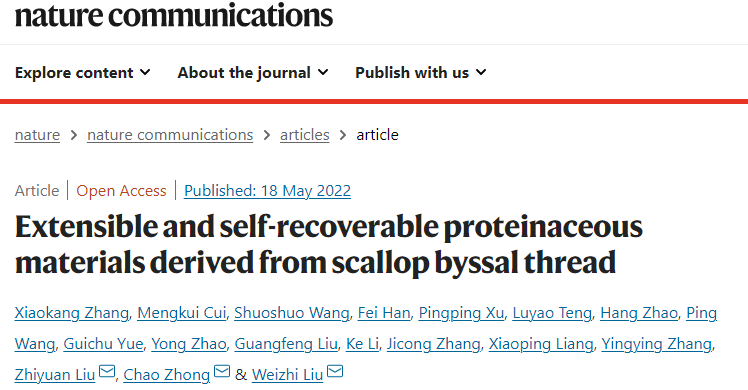Nature Communications |Extensible and self-recoverable proteinaceous materials derived from scallop byssal thread
Biologically derived and biologically inspired fibers with outstanding mechanical properties have found attractive technical applications across diverse fields. Despite recent advances, few fibers can simultaneously possess high-extensibility and self-recovery properties especially under wet conditions.
In a paper published online On 18th May in Nature Communications, researchers from Weizhi Liu's group from Sars-Fang Centre OUC, Chao Zhong's group from shenzhen Institute of Advanced Technology, Chinese Academy of Sciences, and Zhiyuan Liu's team cooperated to report protein-based fibers made from recombinant scallop byssal proteins with outstanding extensibility and self-recovery properties. The paper entitles "Extensible and self-recoverable proteinaceous materials derived from Scallop Byssal Thread". After years of intensive research, the research team has made important research progress in the field of extensible and self-recoverable proteinaceous materials derived from scallop byssal thread.

Researchers initially investigated the mechanical properties of the native byssal thread taken from scallop Chlamys farreri and reveal its high extensibility (327 ± 32%) that outperforms most natural biological fibers. Combining transcriptome and proteomics, theye select the most abundant scallop byssal protein type 5-2 (Sbp5-2) in the thread region, and produce a recombinant protein consisting of 7 tandem repeat motifs (rTRM7) of the Sbp5-2 protein. Applying an organic solvent-enabled drawing process, they produce bio-inspired extensible rTRM7 fiber with high-extensibility (234 ± 35%) and self-recovery capability in wet condition, recapitulating the hierarchical structure and mechanical properties of the native scallop byssal thread. It's further shown that the mechanical properties of rTRM7 fiber are highly regulated by hydrogen bonding and intermolecular crosslinking formed through disulfide bond and metal-carboxyl coordination. With its outstanding mechanical properties, rTRM7 fiber can also be seamlessly integrated with graphene to create motion sensors and electrophysiological signal transmission electrode.
The patents for the new materials have been applied (ZL201810924015.5). The corresponding authors include Professor Liu Weizhi of Sars-Fang Centre, Ocean University of China, and the first author is Xiaokang Zhang, phD student of Ocean University of China and postgraduate Shuoshuo Wang, Mengkui Cui, ph.D. student of ShanghaiTech University, and Fei Han , ph.D. student of Shenzhen Institute of Advanced Technology. The research is supported by the National Natural Science Foundation of China, the Shenzhen Institute of Advanced Technology Open Project, and the Shenzhen Synthetic Biotech Innovation Research Institute.
The link:https://www.nature.com/articles/s41467-022-30415-3


 English
English 中文
中文


